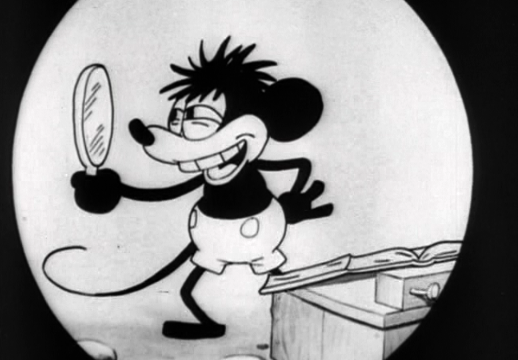The studios were in general startled by the arrival of sound. A lot of things changed in a very short time. Today’s short was probably caught up in those changes, its place in history usurped because “Steamboat Willie” was actually produced with synchronized sound. That’s probably why “Willie” was the first Mickey Mouse cartoon to get distribution, an important step in the days before there was a full-fledged Walt Disney Studios. Heck, for years to come, Walt would distribute his pictures through RKO.
Mickey is obsessed with Lindbergh and therefore decides to learn how to fly a plane. His simulator crashes, but he builds a new plane out of a car and the bits of the old one and the tail of a turkey, why not. He grabs Minnie and takes her into the plane with him. When he’s finally got her in the air, he tries to kiss her. She’s not going for it. He tries to force the issue, and she bails out, using her bloomers as a parachute. He crashes the plane.
I’ve never actually seen any Oswald the Lucky Rabbit shorts—I should really get on that—so you couldn’t prove by me the hypothesis that this story was written for him. I will say that the Mickey we get here bears little resemblance to Mickey as we would come to know him. Then again, Mickey has gone through several incarnations over the years, only gradually settling into what I kind of think of as the Bing Crosby version. But this version is wild and reckless and frankly kind of rapey, and he isn’t even much like the version in “Steamboat Willie.”
Technically, though, this is a rather impressive cartoon. For one thing, Ub Iwerks animated the whole thing in two weeks. He apparently did 700 drawings a day, which is exhausting just to consider. There’s even a camera move, an actual camera move—the first in an animated cartoon. It involved moving the background, of course, because that was easier than moving the camera, but really watch the flight sequence one of these days. I mean, watch the whole cartoon; it’s like six minutes. But the flight sequence is more complicated than what Hanna-Barbera was putting on TV in the ’80s.
I recently discovered that Lillian Disney actually worked on this cartoon. Ub may’ve done all the drawings, but other people, specifically women, still inked and painted it. And Walt did the voices, when they added sound, and Carl Stalling who went on to work for Warners did the music. It was, as with everything else Disney has ever done, a group effort. And yet Walt’s name is the only one that comes up. My brain insists that it ties in somehow to the fact that it was the first Mickey cartoon made—while Walt was still under contract to Universal—and the fourth released, but I’m not sure how. Oh, well. Six minutes of Mickey and a plane; there are worse things.
If you like what you read in these articles, please consider sponsoring me on Patreon.

